- What is the significance of
Lohri and how is it celebrated, in North and across India, under different
names e.g. in Tamil Nadu, Assam & Gujarat. What sweets are prepared during
Lohri?
In every region Lohri is celebrated
differently in all regions but one common factor of Lohri is its fun filled,
happy, dancing, singing characteristic. Lohri is celebrated all over India with
different names, ways, rituals and customs.
The common tradition is to clean and
decorate homes, buy new dresses, dance, sing and prepare sweets. Like all other
festivals, this festival also maintains happy relationships in the family,
caste and community. Lohri is a time for social gathering and enjoyment.
The harvest festival is celebrated every
year marking the end of winter season and beginning of spring, New Year and harvesting
rabi crops. Lohri is the time for festivity, get-together, and worshipping Indra, Surya, Agni and the cattle (gowmata) whose blessings made it possible to get a rich harvest. Unlike other festivals, the date for Lohri festival is fixed.

Dedicated
to fire and the sun god Lohri is the time when the sun transits the zodiac sign
Makar (Capricorn), and moves towards the north. In astrological terms, this is
referred to as the sun becoming Uttarayan.
The new arrangement decreases the intensity of winter and brings warmth to
earth. Lohri night traditionally falls on
the longest night of the year known as the winter solstice. The earth leans towards the sun along the Tropic
of Capricorn (Makar rekha) from the day following Lohri. The earth, farthest
from the sun at this point of time, starts its journey towards the sun along
its elliptical orbit, therefore beginning the onset of spring. It is this change
which is celebrated as Lohri.
 Ganga Sagar.
Ganga Sagar.
Having bath on this day is regarded as most
important. A large number of people bathe in the Sangam at Prayagraj where rivers Ganga, Jamuna, Saraswati meet. A Mela is held every year at Ganga
sagar, Bengal where the Ganges meets the Bay of Bengal. It was here that the river Ganges took the ashes of sixty thousand ancestors of Raja
Bhagiratha to Heaven. People take bath in Ganga Sagar, hoping their ancestors will also get liberated.
Also read Ganga
Sagar pilgrimage
It is known as Makar Sankranti,
Uttarayan, Maghi, in West India,
in South it is known as Pongal and in the North it is called Lohri, Tilori and Khichdi. It is called Maghi Bihu
in Assam, Bhogi in Andhra Pradesh, Makar Sankranti in Karnataka, Bihar and
Uttar Pradesh.
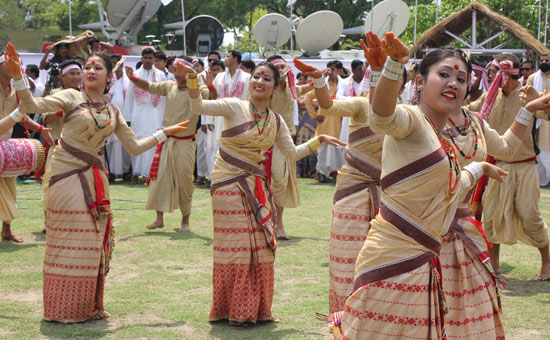 Maghi Bihu Assam.
Maghi Bihu Assam.
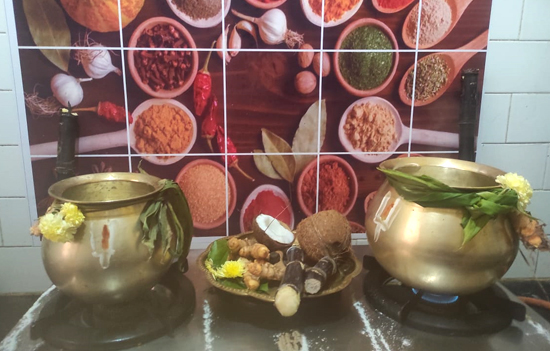 Pongal. Pic by Bindu Krishnan
Pongal. Pic by Bindu Krishnan
In South India,
Pongal is a four
day festival- first day is Bhogi Pongal, celebrated in honour of god
of rains, Indra Deva. Gratitude is expressed towards Indra Deva for abundant harvest, resulting in prosperity. Kolam designs are drawn to decorate homes with white paste of newly-harvested rice.
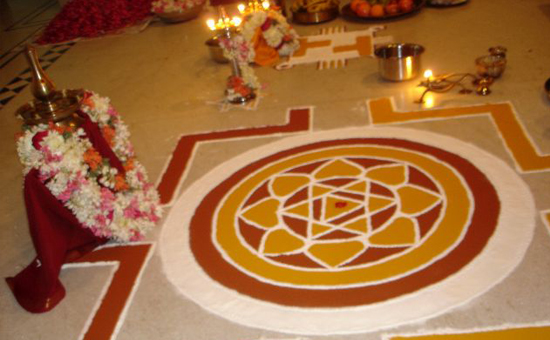 Kolam. Pic by Lakshi Sarma.
Kolam. Pic by Lakshi Sarma.
On Pongal, food is cooked at sunrise in an open place. Rice
and milk is cooked together and milk is allowed to spill over as it is
considered auspicious. It is mixed with ghee, cashew nuts, raisins, and
jaggery. This dish is called Pongal and is offered to Lord Sun, as a sign of
gratitude. Second
day is Surya Pongal, to thank Surya Devata.
Third day is Mattu Pongal when the
cattle (Gowmata) are honoured for
giving milk and for ploughing the fields. Cattle are fed and decorated with
bells and cattle races are organised. The atmosphere becomes full of fun and partying.
Community feasts are held where all dine together. Fourth day is Kaanum
Pongal when relatives and friends meet each other and exchange sweets and
goodies.
On this day in Maharashtra
tilguds are prepared of til (sesame seeds) and sugar and til-laddus are made from til and jaggery. While giving til guls to each other, people say, ‘til-gul ghya, god god bola’ meaning ‘eat tilguls and speak sweet words’.
The tradition in Gujarat is to give gifts to family members and relatives. Known as ‘Sakarat’ in
Bundelkhand and Madhya Pradesh people
exchange sweets and there is an atmosphere of celebration. Delicious recipes
are prepared for Lohri mainly with sugarcane, til and pea nuts like Ganey
Ki Kheer, Atta Ladoo, Nariyal
Chikki, Kaju Chikki, Kurmura Ladoo, Pinnie, Gajak, Shengdana Chikki, Kheer, Gur Gajak.
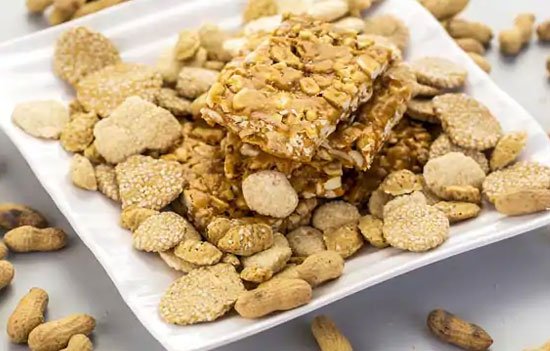 Gajak is very popular.
Gajak is very popular.
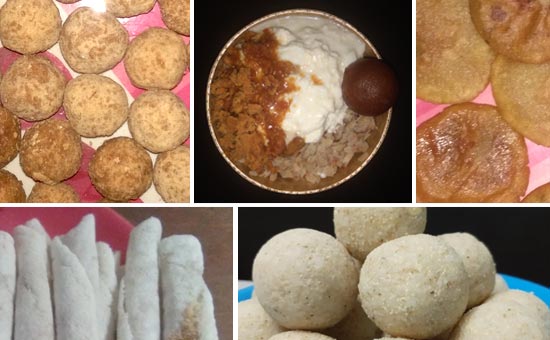 Bihu dishes of Assam.
Bihu dishes of Assam.
Also
read
5
delicious Bihu recipes of Assam
December and January being the coldest
months of the year in Delhi, Uttar Pradesh, Himachal, Haryana and Punjab, huge
fires are lit on Sankrant, as a
gratitude to Agni Deva (the fire god)
called the Lohri fire. People
light bonfires to remove the bitter coldness of January and dance around it in
a mood of happiness and celebrate Lohri.
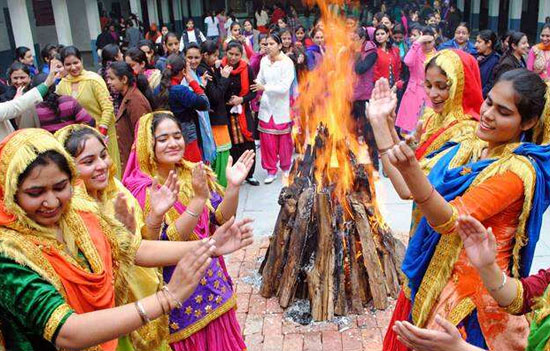 Lohri Fire.
Lohri Fire.
They
do parikrama, going around the sacred
fire three times, praying to Agni
deva to bless the land with abundant
crops and prosperity,
giving offerings of popcorns, peanuts, revari
and sweets to Agni Deva, chanting ‘Aadar aye, dilather jaye’ (May honour come and poverty vanish). Prasada of til, gazak, gur,
moongphali, phuliya and popcorn is distributed among all.
People
dance around the fire, to the beat of dhol
(traditional Indian drum). Dholak is
played; bhangra dance is done by male
folks while the females do Giddha and
Kikli.
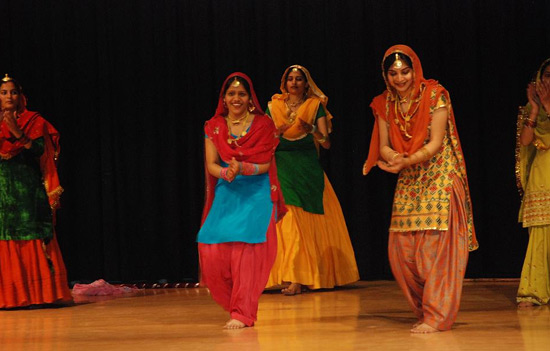 Giddha.
Giddha.
Also
read
Folk
Dances of North India
Dances of Lohri symbolize energy, strength
and excitement of the people, after a good harvest. Khichri, makki di roti with sarson ka saag (cooked mustard herbs) is specially prepared for the
occasion. In olden times, melas were
held in which races, singing, wrestling bouts, acrobatics were held, old and
young all wore new clothes. People from faraway places travelled on their
bullocks to participate in Lohri fairs.
In homes where there is a new-born or a
newlywed, Lohri is celebrated with even greater enthusiasm. Feasts are arranged for the people
as Lohri is a festival of fertility and very important for the baby and new
bride. The first Lohri of a new born is a special occasion in which all the guests bring gifts for the baby and mother. The child's mother dresses up in jewellery and mehndi on her hands and feet sits with
the baby in her lap while everyone puts fruits, sweets, clothes, jewellery and money in her
lap.
The first Lohri of a bride is considered very important. It is
celebrated on a large scale just like a wedding. The recently wedded bride is given
gifts along with dry fruits, revari (sweet
made of sugar and sesame seeds), peanuts, and sesame ladoos. Sweets made of molasses and sesame seed are sent to
relatives and friends. Groups of little children go singing round the village
collecting 'gur' and 'rewari' for themselves. Eating til (sesame seeds) and rorhi
(jaggery) is considered essential on this day. Possibly the words til and rorhi merged to
become tilorhi, which eventually
got shortened to Lohri.
There are some interesting
folk-tales connected with Lohri. According to some legends Dulla Bhatti was the Raja of Pindi
Bhattian. Bhatti was a Rajput tribe during the reign of Akbar, which inhabited
parts of Rajasthan, Punjab, and Gujarat (now in Pakistan). The tribal mirasis (street singers) trace the history of the tribe and
interestingly, claim Maharaja Ranjit Singh as one of its scions. It is said
that he was put to death by the Mughal king for revolting against him. Some
legends say that he was a bandit. Dulla
Bhatti robbed
the rich landlords and gave
that money to the poor. Due to his bravery, he became a hero
of the people of Punjab. He rescued Hindu girls who were forcibly taken to be
sold in slave market and arranged their marriages to Hindu boys.
A
week before Lohri, small groups of children visit houses and sing
Lohri folk songs related to Dulla Bhatti and his bravery. In turn, people
give them popcorn, peanuts, crystal sugar, sesame seeds or gur and money.
‘Sunder
mundriye ho, tera kaun vichaara ho, Dulha bhatti wala ho, Dulhe ne dhee vehaai
ho, Ser shakkar paai ho, Kudi da laal pathaka ho, Kudi da saalu paata ho,
Salu kaun samete ho, Chacha gali dese ho, Chache choori kutti ho, zamidara
lutti ho, Zamindaar sudhaye ho, Bum Bum bhole aaye ho, Ek bhola reh gaya,
Sipahee far ke lai gaya, Sipahee ne mari itt, Paanvey ro te paanvey pitt,
Sanoo de de Lohri, te teri jeeve Jodi, Bas-bas eh fad 10 rupaiye te agge vadh’
Beautiful girls, who will save you, Dulla of bhatti tribe, Dulla got his daughter married and gave one kilo sugar as dowry, girl is very pretty, girl’s shawl is very long, who will wrap the shawl, uncle is shouting at her, aunty is preparing sweets, rich have been looted, rich are shouting, army of poor has looted, one poor is left behind, constable has caught him, a brick hits the constable, he will cry or lament but give us lohri, and you will always get happiness, okay now stop, take ten rupees and go to the next house.
Lohri is enjoyable as people gather together at one place while in Diwali people individually visit others’ homes. In Lohri people eat sweets together around the fire and makki di roti (multi-millet hand-rolled bread) is traditionally eaten with sarson ka saag (cooked green leafy herbs) with lot of songs and dances.
Makki de roti te sarson da saag, suraj
diyaan kirna, khushiyaan di bahaar,
nachde ne saare te vich baldi aag,dhol di awaaj te nachdi mutiyaar,
Mubaarak hove sarkaar Lohri da tyohaar.
Makki roti with sarson saag, awaiting sun’s rays, lots of happiness, everyone dancing around the fire, girls dancing on beats of dhol, wishing everyone a very happy lohri festival.
To
read all articles by author
To
read all articles on Indian Festivals
Author Seema Burman has been writing high quality columns on culture and spirituality for years including for Speaking Tree.
Also read
1.
Why
is Makar Sankranti celebrated
2.
How
Pongal is celebrated over 4 days
3.
The
Bonfires of Magh Bihu
4.
Significance
of Kolam
5.
How
Dussehra is celebrated across India
6.
How
Holi is celebrated across India